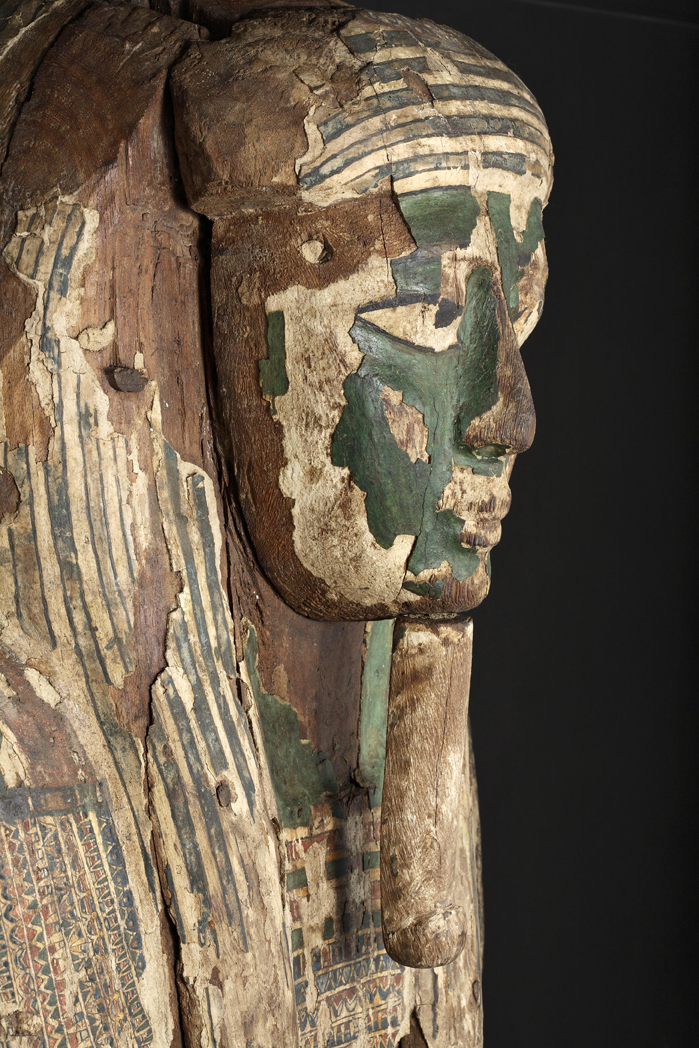
Click here to view image
Egyptian sarcophagus of Pasherienaset
Emanuele N. Figari 1931 donazione
ambito egizio
Edfu, Egypt, senteenth-sixth century BC
sarcophagus
Late Period of ancient Egypt - 664 BCE - 525 BCE
Unità di misura: cm; Larghezza: 52; Lunghezza: 175,5; Spessore: 45,5
Legno- stuccatura; pittura; verniciatura
The sarcophagus is anthropoid, or mummiform (i.e. ideally reproducing the body inside), made of sycamore wood and contains the mummy of the priest Pasherienaset. It was probably found in Edfu, in the area of the Nag el-Hassaia necropolis. The preparatory layer does not contain canvas to cover the joints of the wood as was typical in sarcophagi of the time (for chemical and structural analyses see also: E. Franceschi, M. Nicola, G. L. Nicola, A. Chimienti, S. Coluccia, ""Indagini non-invasive XRF, rilievi tridimensionali colorimetric e restauro di sarcofagi egizi della XXVI dinastia: due casi a confronto"", in ""VI Congresso Nazionale IGIIC - Lo Stato dell'Arte - "" Spoleto, 2 - 4 October 2008). The artefact consists of 31 wooden elements held together by wooden pegs and stucco. The colours on the outer surface have changed due to oxidation. The surface of the sarcophagus, both inside and outside, is decorated with figures from religious funerary iconography taken from the Book of the Dead. On his head he wears a tripartite wig and his green face connects the deceased to Osiris, god of vegetation and the afterlife. The false beard also alludes to the divine nature of the deceased. The chest is adorned with a usekh collar, a necklace consisting of several pendants inspired by the plant world and ending in a red-painted falcon's head on each of the two shoulders. On either side of the necklace, on the upper part of the arms, scenes of devotion to Osiris are depicted; from these scenes, columns develop towards the shoulders, on which funeral offering formulas are written. Below the collar is the goddess Nut, personification of the sky (who also appears under the lid), welcoming her son, “Osiris” Pasherienaset, into her arms. The surface of the legs is divided into three sections, the central one bearing texts from chapter 89 of the Book of the Dead, written in four columns extending down to the feet. The text calls for the reunion of the ba, one of the souls of man according to Egyptian belief, with the body; this belief is echoed in the scene depicting the ba in the form of a bird with a human head offering a shen ring, symbol of eternity, to the reclining, embalmed body of the deceased. Under the bed are the four canopic jars used to contain the deceased's entrails and linked to the four “Sons of Horus” depicted on the lids. On each of the side sections, under a representation of the sky with five-pointed stars, are eleven figures facing the head of the sarcophagus. Other funeral offering formulas are shown on the feet. Under the divine theories, the snake “Tail in Mouth”, renamed Ouroboros in Roman times and symbolising the eternal cycle of life, wraps around the entire sarcophagus, with the two ends joining at the feet. The end of the sarcophagus corresponding to the head is surrounded by a floral garland, inside which is the lower part of the goddess Nephthys with outstretched wings, kneeling on the gold nebu, guarantor of eternity. At the opposite end is the goddess Isis in the same position, holding a Maat feather. On the outside of the coffin, at the spine of the deceased, there is a djed pillar, another emblem of the god Osiris, of which only part of the base and upper end remain. On either side of the pillar are a series of panels in which, at the left shoulder, there is another figure of Isis with an ankh in her right hand. The other panels feature a series of other deities. The goddess Nut is depicted on the inside bottom of the lid, while the goddess Imentet, personification of the West, the land of the dead according to Egyptian funerary culture, is depicted on the inside bottom of the coffin.




